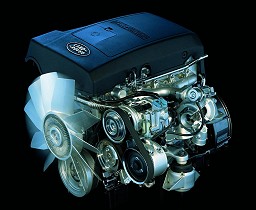Introduction to the Td5

From January 1999, the Land Rover Defender range was fitted as standard for most markets with the new Td5 diesel engine. The Discovery Series II was fitted with the Td5 from launch, also in January 1999.
The five cylinder direct injection turbo diesel intercooled engine was a brand new design, started by Rover Group in 1993 as part of their development of a range of 4, 5, and 6 cylinder diesel engines to meet all Rover and Land Rover diesel engine requirements. This new range of engines was loosely based upon the L-series 4 cylinder engine, at that time used in the Freelander and various Rover cars.
When BMW bought Rover Group in 1994, the 5-cylinder project's continuation was approved, to replace the Tdi in the Discovery and Defender.
The project was already under way before BMW's takeover, and so contrary to popular belief, the Td5 is in fact a Rover design, not a BMW one. Before starting on project 'Storm', as the Td5 was known during development, Rover's engineers undertook a huge review of competitor's engines, designs and manufacturing practices. The lessons learnt were combined with Rover Group's already extensive experience with the 200 and 300 Tdi and the Rover L-series diesel engines.
In Defender specification, the Td5 develops 122 bhp (120 PS, 90 kW) at 4200 rpm, and in the Discovery this is upped to 136 bhp (134 PS, 101 kW) at 4200 rpm by use of a different fuelling map and an electronic wastegate. Along with 300 Nm (221 lb.ft) of torque at 1950 rpm, these relate to a 9% increase in power and 13% more torque than the outgoing 300 Tdi engine. From 2002 the Discovery automatic was uprated to produce 340 Nm (250 lb.ft) of torque at the same engine speed.
The Td5 uses Electronic Unit Injectors to burn exactly the right amount of fuel, which mean that when first released, the emissions are so clean that was no need for a catalytic converter in order to meet emissions regulations (EU2).
With the introduction of EU3 regulations, the engine gained an Exhaust Gas Regulation (EGR) cooler, as well as a catalytic convertor in the exhaust.
The dual chain-driven overhead camshaft pressurises the fuel in the injectors to 1500 bar (22,000 psi) compared to around 600 bar (9,000 psi) in the Tdi, and this is one of the key advantages of using EUI technology, as it provides good emission control due to the very high pressure of fuel injection. The high pressure in the Td5 is possible because each injector has a camshaft driven pump, so there is no problem with containing high pressure fuel in fuel rails.
Injection of the fuel is controlled by the ECU, which controls the fuel spill valve inside the injector, and this allows fuel to be injected into the cylinder.
The oil filtration method has been greatly improved over the 300 Tdi, with a centrifugal particle filter fitted ahead of the normal filter. This means that oil changes are now only required every 12,000 miles (20,000 km), compared to 6,000 miles (10,000 km) for the 300 Tdi and most other competitors.
The Td5 is the first diesel engine in the Defender to be wholly controlled by an engine management (or control) unit (EMU/ECU) - codenamed 'Thunder' and developed in conjunction with Lucas. The ECU regulates fuel delivery by taking into account a number of factors from the engine and the surroundings - such as inlet air pressure and temperature, intake air flow, coolant temperature and the throttle pedal position from the fly-by-wire accelerator.
The ECU also controls the glow-plug timing and is connected to the alarm to form the main part of the immobiliser system. The ECU improves drivability by taking inputs from the clutch, brake and throttle pedal to smooth out gear changes and reduce driveline shunt. With low range selected on the new LT230Q transfer box, the ECU enables Fast Throttle Control (FTC) which widens pedal travel, giving more control over the engine speed in off road and low speed operation.
Back to Td5 KB
|